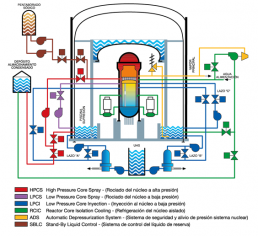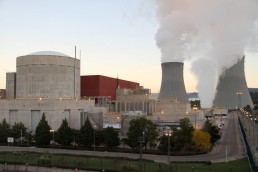- Home
- About us
- Characteristics and operation
- Nuclear safety
Nuclear safety
In order to cover possible failure in the normal reactor heat extraction system, in other words, energy generation, an emergency system is available with sufficient capacity and redundancies to maintain the core cooled until the reactor reaches a safe stop condition, without exceeding limits for protective coating pressure and design temperature for the fuel, forestalling the escape of fission products to the outside.

Safety, as it is construed and applied nowadays to nuclear reactors (a concept of strong security or “defense in depth”), has two clear objectives:
- To minimize the probability of an accident.
- To minimize the consequences thereof, should it happen to occur.
This double understanding is expressed in three postures of action that condition the design, construction and operation of modern nuclear power plants:
- Incorporation of an inherent foundation in safety in planning and design.
- Observation of a rigorous quality control.
- Incorporation of protection and safety systems at the plant.
By inherent foundation in safety, we mean the application of principles of design by which the very laws of nature and physics prevent certain types of accidents. For instance, reactor cores are designed so that the coefficient of its total power is negative. This means that if the core power level should begin to rise for any reason, an opposing feedback to this increase favouring its decrease shall be produced spontaneously and instantly.
On the other hand, all processes and products undergo strict quality control during planning, design, manufacturing, construction and operation of the plant and its equipment. With this in mind, the engineers, advisors, contractors and suppliers have had to establish special quality control organizations.
The most important functions as regards the systems of protection in a nuclear power plant are immediately stopping the reactor (braking the nuclear chain reaction) facing any abnormal condition, the start-up of the safety systems and preventing operating errors. These safety systems unite rigorously strict conditions of reliability.

Cofrentes NPP counts on four measuring and signal transmitting channels for each variable implicated in safety monitoring. In order for a stop to take place, two of the four channels must coincide. Likewise, a spurious signal in one channel will not provoke an unwanted stop, for absence of concurrence.
Moreover, of the auxiliary reactor systems needed for normal operations and the auxiliary support systems for taking action in abnormal operating conditions, water reactors must be equipped with safety systems that forestall the risk of radioactive products encroaching into the environment in the event of a large-scale reactor piping fracture. In order to prevent such scenarios with the loss of coolant, water reactors are furnished with special containment constructions and emergency core cooling systems.
Containment and the incorporated elements (suppression pool, sprinklers, isolating valves for cross piping, etc.) are implemented to ensure that steam and water, escaping from the reactor vessel in the event of a piping fracture, are contained. If the fracture occurs outside containment, the isolating valves for the affected piping are shut so as to forestall water (or steam) escaping from the reactor vessel outside of containment through the fracture.
